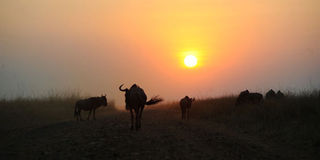Leaders raise the alarm over decline in Mara park animals

PHOTO | SULEIMAN MBATIAH Wildebeest at Maasai Mara National Reserve in July 2013. Narok Governor Samuel Tunai said the numbers of some wild animals have reduced by over 70 per cent, threatening the region’s cash cow.
What you need to know:
- Hunting and grazing by herders blamed as Kandie threatens to pull down illegal structures
Experts have raised the alarm over the decline in the number of wild animals at the world famous Maasai Mara Game Reserve.
A workshop that was attended by Tourism Cabinet Secretary Phyllis Kandie was told that the population of some animals has declined by 70 per cent as they have to compete for pasture with cattle entering the reserve.
Haphazard erection of lodges and camps at the reserve, which are located in areas meant for conservation, was also blamed for the decline. Some of the animals whose numbers have decreased include giraffes, impalas and warthogs.
It is Narok governor Samuel Tunai who blew the whistle on the crisis adding that buffalos and wild dogs have almost disappeared, while huge numbers of wildebeest no longer pass through the region on their epic migration as it was five years ago.
“We want to limit human activities in the Mara to safe wildlife,’ said Mr Tunai.
The Cabinet Secretary echoed the same sentiments saying urgent measures will be put in place to protect the tourist product from further degradation.
Ms Kandie ordered the building of illegal structures to stop forthwith and called on joint efforts between county and national governments to bring the shine back to Mara.
“The government will not seat back and watch the prestige of the world famous Maasai Mara eroded,’ said Ms Kandie.
However, she added that the government has embarked on an aggressive marketing strategy to ensure Kenya doubles the number of tourists to three million.
“We will have to diversify products on offer to include cultural, sport, conference, ecosystem and medical tourism,” she added.
During the forum the National Environment Management Authority (Nema), and Kenya Wildlife Service were blamed for the increasing encroachment of the park and the rise in poaching.
The meeting was told that the country has lost 162 elephants and four rhinos.
Nema was accused of authorising more than 30 camps to be built in the reserve without following the due process as provided by the law.
More than 200 camps and lodges have been built mostly in rhino breeding areas, water points, or along the river Mara.
But Nema director general Geoffrey Wambugu, who was in the forum, denied the claims.
“We have carried out an audit which revealed that fake Nema documents were used to put up the camps and we have taken the necessary action against the culprits,” said Mr Wambugu.
Herders living around the park were also put on the spot for grazing their animals inside the park.
The cattle end up competing with wild animals for the pasture, endangering the park further.
At the same time, Taita-Taveta governor John Mruttu has offered to help KWS contain poaching in Tsavo conservancy.
Mr Mruttu said the county would support KWS in efforts to stop poachers using poisoned arrows and snares to kill elephants.
Five jumbos killed
He warned that the killing of elephants in Tsavo could deal a major blow to tourism in the country.
This comes after one elephant died of snare injuries two weeks ago.
The death brought the number of elephants which have died in the last three months to five after four others died of poisoned arrow injuries.
The governor said he would support conservation efforts since 62 per cent of the county is a conservation area.
“Elephants are an important natural resource as 62 per cent of my county is a wildlife conservation area,” he said. He added:
“I will do anything to protect elephants against poachers as without them we will not be able to attract tourists.”




